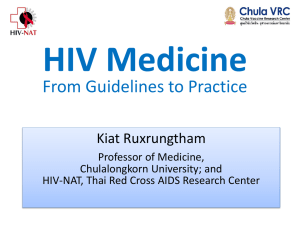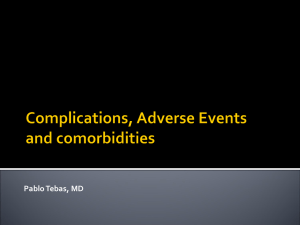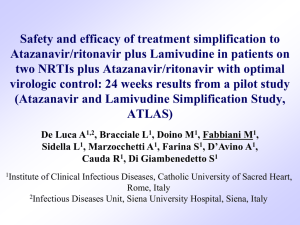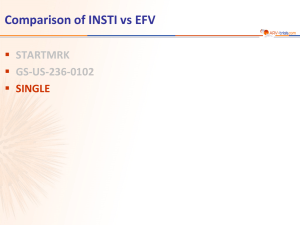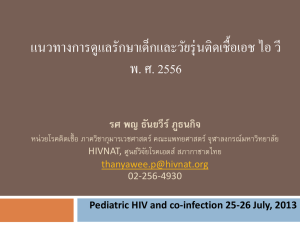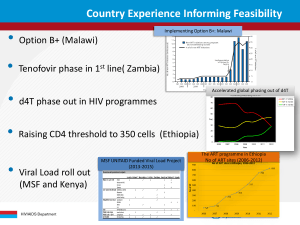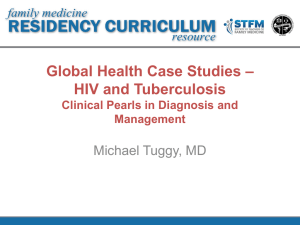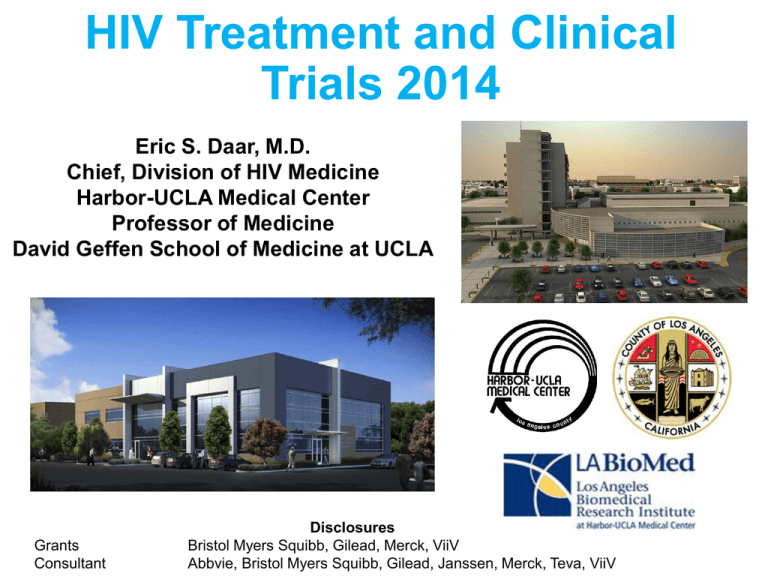
HIV Treatment and Clinical
Trials 2014
Eric S. Daar, M.D.
Chief, Division of HIV Medicine
Harbor-UCLA Medical Center
Professor of Medicine
David Geffen School of Medicine at UCLA
Grants
Consultant
Disclosures
Bristol Myers Squibb, Gilead, Merck, ViiV
Abbvie, Bristol Myers Squibb, Gilead, Janssen, Merck, Teva, ViiV
Overview
• Pathogenesis
• Treatment
– When to start
– What to start
– When to switch
• Treatment as prevention
• Future
Viral Dynamics
Productively Infected
CD4+ Lymphocytes
Infected Resting Memory
CD4+ Lymphocytes
Activated Uninfected
CD4+ Lymphocytes
Activated Uninfected
CD4+ Lymphocytes
Perelson A, et al. 1995
Long-lived Cells
Viral Dynamics
Productively Infected
CD4+ Lymphocytes
Infected Resting Memory
CD4+ Lymphocytes
>95%
Log10 RNA
T1/2~1 day
Activated Uninfected
CD4+ Lymphocytes
Weeks
Activated Uninfected
CD4+ Lymphocytes
T1/2~20 min.
Long-lived
Cells
Viral Dynamics
Productively Infected
CD4+ Lymphocytes
Infected Resting Memory
CD4+ Lymphocytes
>95%
T1/2~1 day
T1/2~20 min.
Activated Uninfected
CD4+ Lymphocytes
<5%
Log10 RNA
T1/2~2-4 weeks
Activated Uninfected
CD4+ Lymphocytes
Long-lived Cells
Weeks
Viral Dynamics
Productively Infected
CD4+ Lymphocytes
Infected Resting Memory
CD4+ Lymphocytes
<1%
Log10 RNA
>95%
T1/2~6 monthsyears
T1/2~1 day
Weeks --- Year
T1/2~20 min.
Activated Uninfected
CD4+ Lymphocytes
<5%
T1/2~2-4 weeks
Activated Uninfected
CD4+ Lymphocytes
Long-lived Cells
Lessons From Pathogenesis
• High levels viral replication makes mutations
(resistance) inevitable if detectable viremia
• Persistent cellular reservoirs of infection
established early in course of infection
– Source of archived virus throughout course of disease
• Viral rebound likely regardless of duration of viral
suppression with current therapeutic options
Antiretroviral Activity:
An Historical Perspective
HIV RNA change (log10 c/mL)
1987: AZT
Monotherapy
1994:
Two-Drug Therapy
1997:
HAART
0
0
0
-0.5
-0.5
-0.5
-1
-1
-1
-1.5
-1.5
-1.5
-2
-2
-2
-2.5
-2.5
-2.5
-3
24-week response
-3
24-week response
Fischl, NEJM, 1987
Katzenstein, NEJM, 1996
Eron, NEJM, 1995;
Hammer, NEJM, 1996
-3
24-week response
Gulick, NEJM, 1997;
Cameron, Lancet, 1998
Life Expectancy of HIV-Infected
Patients
• Life expectancy of
Athena cohort to
general population
(n=4,174)
• Expected life years
remaining at age 25
– 53.1 (44.9-59.5) for general
population
Age at time of death
Remaining life years
– 52.7 for asymptomatic HIV+
patients
General population
Asymptomatic HIV+ patients
van Sighem A, et al. AIDS 2010; 24:1527-1535
Awareness of Serostatus Among
People with HIV and Estimates of
Transmission
~25%
Unaware
of
Infection
~54%
New
Infections
Accounting for:
~75%
Aware
of
Infection
People Living with HIV
Marks, et al, AIDS 2006;20:1447-50
~46%
New
Infections
New Sexual Infections
Revised CDC Recommendations for
HIV Testing in Healthcare Settings
• Routine voluntary testing
for patients ages 13 to 64
years in healthcare settings
– Not based on patient risk
• Opt-out testing
• No separate consent for
HIV
• Pretest counseling not
required
• Repeat HIV testing left to
discretion of provider
– Based on patient risk
Branson BM, et al. MMWR Recomm Rep. 2006;55(RR-14):1-17.
Rapid HIV Testing
HIV Cascade
When to Start?
Why not treat everyone?
•
•
•
•
Not ready to commit to treatment
Short-term and long-term toxicity
Need for life long therapy
Risk of virologic failure, resistance and crossresistance
• Limited evidence for earlier therapy being
associated with better outcomes than delayed
therapy
Physical Manifestations of Fat
Redistribution Syndromes
Case for earlier therapy
CIPRAHT001: Randomized Trial
of When to Start ART in Haiti
Randomized clinical endpoint study of when to start therapy
• Treatment-naive
• No hx AIDS-defining illness
• CD4 200-350
Early Treatment
(Immediate ZDV/3TC + EFV)
Primary
endpoint:
Survival
Standard Treatment
(Delay until CD4+ <200 or AIDS
Baseline Characteristics
Early (n=408)
Standard (n=408)
40
40
Male (%)
41%
44%
Median CD4+ (cells/mm3)
280
282
Body Mass Index (kg/m2)
21.4
21.0
Median age (years)
Severe P, et al. NEJM 2010 363:257-265.
CIPRAHT001: Clinical Endpoints
May 2009: DSMB review stopped study due to excess
deaths in Defer Treatment arm
Early
Standard
Hazards Ratio
(p value)
Death
6
23
4.0
(.0011 )
Incident
Tuberculosis
18
36
2.0
(.0125 )
Clinical Endpoints
• Infectious causes of death
– Early: 1 (gastroenteritis)
– Standard: 17 (7 gastroenteritis, 5 TB, 4 pneumonia, 1 cholangitis/sepsis)
• More toxicity from ART and intensive need for lab f/u for deferred grp
• WHO start guidelines now modified to <350 cells/uL
Severe P, et al. NEJM 2010 363:257-265.
NA-ACCORD: Risk of Death with ART
Deferral
351-500 CD4+
>500 CD4+
RR
95% CI
P
RR
95% CI
P
Deferral of ART
1.7
1.3, 2.3
<0.001
1.9
1.4, 2.8
<0.001
Female Sex
1.2
0.9, 1.6
0.24
1.9
1.3, 2.6
<0.001
Older Age (per 10
years)
1.7
1.5, 1.9
<0.001
1.8
1.6, 2.1
<0.001
Baseline CD4 count
(per 100 cells/mm3)
1.1
0.7, 1.8
0.59
0.9
0.9, 1.0
0.03
Kitahata M, et al. New Engl J Med 2009;360:1815-26.
Ultimate CD4 Cell Count Depends on
Where You Start
ATHENA National Cohort2
1000
800
600
400
≥500
350-500
200
200-350
50-200
<50
0
0
48
96
144
192
240
Weeks From Starting ART
Gras L, et al. J Acquir Immune Defic Syndr. 2007;45(2):183-192.
288
336
Neurocognitive disorders associated
with CD4 nadir
Odds Ratio for Cognitive Impairment by CD4 Nadir
1.1
1
Odds Ratio
0.9
0.8
0.7
0.6
0.5
0.4
0.3
<50
50-199
200-349
CD4 Nadir
Odds Ratios for NP Impairment
Ellis R, et al. 17th CROI; San Francisco, CA; February 16-19, 2010. Abst. 429.
≥350
Consequences of stopping ARVs:
SMART Trial
HIV-1-infected
patients with
CD4+ cell count
> 350 cells/mm3
(N = 5472)
95.4% treatment
experienced
Continuous antiretroviral therapy
throughout follow-up
(n = 2752)
ART stopped/deferred until CD4+
<250 cells/mm3 then started to
increase CD4+ to >350 cells/mm3
(n = 2720)
El-Sadr W et al. N Engl J Med. 2006; 355:2283-2296.
SMART: Primary endpoint and
components
Endpoints
#Pts w/ Events
Relative Risk (95% CI)
2.5
Progression of Disease or
Death
164
Death
84
Serious HIV Events
21
1.9
6.1
>
1.5
Severe Complications*
114
*CVD, Renal, Hepatic Events (fatal/nonfatal)
►
0.1
El-Sadr W et al. N Engl J Med. 2006; 355:2283-2296.
1
Favors DC
Favors VS ►
10
SMART: Changes in D-Dimer and
IL-6 Levels
Change in Log IL-6 (pg/mL) and
HDL (μmol/L) BL to 1 Month2*
Change in D-Dimer*, BL to 1 Month
0.3
0.3
∆ IL-6 (pg/mL)
0.2
0.11
0.04
0
0
≤400
40110,000
10,00050,000
>50,000
Month 1 HIV RNA (c/mL)
• Suggests HIV viremia effect on endothelium,
leading to increased tissue factors and initiation of coagulation
cascade
P=.0003 for trend
0.3
0.2
0.2
0.1
0.1
0
0
-0.1
-0.1
-0.2
-0.2
P<.0001 for trend
-0.3
-0.4
≤400
401-10,000
10,000-50,000
>50,000
Month 1 HIV RNA Level (copies/mL)
*DC patients on ART at baseline with HIV RNA ≤400 copies/mL
1Kuller
0.4
L, et al. PLoS 2008;10:1496-1508. 2SMART/INSIGHT: Duprez et al, CROI, 2009.
-0.3
-0.4
∆ HDL (μmol/L)
μg/mL
P=.0005 for trend
0.1
∆ IL-6
∆ HDL
0.4
0.28
HPTN 052: Immediate vs Delayed
ART in Serodiscordant Couples
HIV-infected, sexually
active serodiscordant
couples; CD4+ cell count
of the infected partner:
350-550 cells/mm3
(N = 1763 couples)
Immediate ART
Initiate ART at CD4+ cell count 350-550 cells/mm3
(n = 886 couples)
Delayed ART
Initiate ART at CD4+ cell count ≤ 250 cells/mm3*
(n = 877 couples)
*Based on 2 consecutive values ≤ 250 cells/mm3.
• Primary efficacy endpoint: virologically linked HIV transmission
• Primary clinical endpoints: WHO stage 4 events, pulmonary TB,
severe bacterial infection and/or death
• Couples received intensive counseling on risk reduction and use of
condoms
Cohen MS, et al. IAS 2011. Abstract MOAX0102.
Cohen MS, et al. N Engl J Med. 2011 Jul 18. [Epub ahead of print]
Linked HIV Transmission Events
n=27; incidence rate
1.7 per 100 p-y (95% CI 1.1, 2.5)
n=1; incidence rate
0.1 per 100 p-y (95% CI 0.0, 0.4)
Cohen M, et al. NEJM July 18, 2011.
Rationale for Recommending Therapy
for Those with >350 CD4 cells/uL
• Recent cohort studies (4 for 350-500 cells/uL
and 1 for >500 cells/uL)
• HIV replication associated with non-AIDSdefining diseases (e.g. cardiovascular, renal,
liver, malignancy)
• Evidence that ARVs may reduce risk of
transmission
• ARV more effective, convenient, better tolerated
than in the past
US Department of Health and Human Services. Available at: http://aidsinfo.nih.gov/Guidelines.
When to Start Treatment
Clinical
Category
CD4 Count
(cells/mm3)
DHHS
2013
IAS-USA
2012
EACS
2012
BHIV
2012
WHO
2013
AIDS/Severe Sx
Any value
R
R
R
R
R
Asymptomatic
≤350
R
R
R
R
R
350 to ≤500
R
R
C
D
R
>500
R
R
D
D
D
Pregnant
women
Any value
R
R
R
R
R
HIV-associated
nephropathy
Any value
R
R
R
R
R
HIV/HBV
Any value
R
R
R
R
R
HIV-neg partner
Any value
R
R
C
C
R
DHHS Mar 2013: http://www.aidsinfo.nih.gov/ContentFiles/AdultandAdolescentGL.pdf;
IAS-USA: Thompson MA, et al. JAMA. 2012; 308: 387-402;
EACS Nov 2012. http://www.eacsociety.org/Portals/0/files/pdf%20files/EacsGuidelines-v6.1-2edition.pdf;
BHIV 2012: http://www.bhiva.org/TreatmentofHIV1_2012.aspx;
WHO June 2013: http://apps.who.int/iris/bitstream/10665/85321/1/9789241505727_eng.pdf
What to start?
HIV replication cycle and sites of drug activity
NRTIs
AZT (Zidovudine-Retrovir)
ddI (Didanosine-Videx)
ddC (Zalcitabine-Hivid)
d4T (Stavudine-Zerit)
3TC (Lamivudine-Epivir)
ABC(Abacavir-Ziagen)
FTC (Emtricitabine, Emtriva)
NNRTIs
Efavirenz (Sustiva)
Delavirdine (Rescriptor)
Nevirapine (Viramune) (XR)
Etravirine (Intelense)
Rilpivirine (Edurant)
nRTI
Cellular DNA
Tenofovir DF
(Viread)
Nucleus
Protease Inhibitors
Indinavir (Crixivan)
Ritonavir (Norvir)
Saquinavir (Fortovase)
Nelfinavir (Viracept)
Lopinavir/ritonavir (Kaletra)
Atazanavir (Reyataz)
Fos Amprenavir (Lexiva)
Tipranavir (Aptivus)
Darunavir (Prezista)
HIV Virions
New HIV
particles
Reverse
Integrase
Transcriptase
Protease
Capsid
proteins
and viral
RNA
CD4
Receptor
Fusion Inhibitor
T-20
(Enfuvirtide,
Fuzeon)
Viral RNA
Integrase Inhibitor
Raltegravir (Isentress)
Elvitegravir /COBI
Dolutegravir (Tivicay)
CCR5 Antagonist
Maraviroc (Celsentri)
1
Attachment
Unintegrated
double stranded
Viral DNA
3
2
Uncoating
Integrated
viral DNA
Reverse
Transcription
Viral
mRNA
4
Integration Transcription
gag-pol
polyprotein
5
Translation
6
Assembly and
Release
Factors to consider in choosing firstline therapy
• Patients willingness to commit to therapy
• Baseline resistance
• Efficacy data
• Tolerability
• Convenience
• Comorbid conditions
• Consequences of failure (resistance)
• Since the introduction of potent ARV therapy
preferred regimens all include NRTIs + third drug
Which Nucleoside Reverse
Transcriptase Inhibitor?
A5202: Study Design
HIV-1 RNA ≥1000 c/mL
Arm
A
Any CD4+ count
> 16 years of age
ART-naïve
1857
N=1858
enrolled
B
Randomized
Randomized 1:1:1:1
1:1:1:1
C
Stratified by screening HIV-1 RNA
TDF/FTC QD
ABC/3TC Placebo QD
ABC/3TC QD
TDF/FTC Placebo QD
TDF/FTC QD
ABC/3TC Placebo QD
EFV
QD
EFV
QD
ATV/r
QD
(< or ≥ 100,000 c/mL)
Enrolled 2005-2007
Followed through Sept 2009,
96 wks after last pt enrolled
D
ABC/3TC QD
TDF/FTC Placebo QD
ATV/r
QD
A5202: Time to Virologic Failure in
Patients with HIV RNA >100,000 c/mL
Probability of No Virologic Failure
100
Probability of No Virologic
Failure (%)
TDF-FTC (26 events)
80
ABC-3TC (57 events)
60
40
P<0.001, log-rank test
Hazard ratio, 2.33 (95% CI, 1.46-3.72)
20
0
0
12
24
36
48
60
72
84
96
108
Weeks since Randomization
No. at Risk
ABC-3TC
398
363
313
267
222
188
137
87
49
20
TDF-FTC
399
361
321
284
236
204
160
104
65
23
Sax PE, et al. NEJM 2009;361:2230-2240.
ABC/3TC vs. TDF/FTC
Time to Virologic Failure
(End of Study: Low Viral Load Stratum)
Sax P, et al.
JID 2011
Which third drug to combine
with NRTIs?
Boosted-Protease Inhibitors
KLEAN1
(ITT-E, TLOVR)
48 weeks
100
100
66
80
CASTLE3
(ITT, NC=F)
96 weeks
ARTEMIS2
(ITT, TLOVR)
96 weeks
100
79
80
71
65
80
68
60
60
60
40
40
40
20
20
20
n=434
0
n=346
N=444
LPV/r FPV/r
400/100 700/100
BID
BID
0
74
n=343
LPV/r DRV/r
QD or 800/100
BID
QD
n=443
0
n=440
LPV/r ATV/r
400/100 300/100
BID
QD
Adapted from: 1. Eron J, et al. Lancet 2006; 368:476-482; 2. Mills A, et al. AIDS May 29, 2009
3. Molina J-M, et al. 48th ICAAC/46th IDSA , Washington, DC, 2008. Abst. H-1250d
ATV/r vs. EFV
Primary Endpoint
Daar ES, et al. Ann Intern Med 2011
A5202: Overall ITT
Percent of Failures with Emergence
of Major Resistance Mutations*
ABC/3TC
TDF/FTC
p=0.0003
p=0.046
Percent
p<0.0001
A
N
Y
M
A
J
O
R
Viral failures
No baseline resistance N=
p<0.0001
A
N
Y
N
N
R
T
I
N
R
T
I
P
I
p-values:
ATV/r vs. EFV
(amongst failures)
M
A
J
O
R
A
N
Y
A
N
Y
N
N
R
T
I
N
R
T
I
P
I
M
A
J
O
R
N
N
R
T
I
N
R
T
I
P
I
M
A
J
O
R
N
N
R
T
I
N
R
T
I
ATV/r
EFV
ATV/r
EFV
76
63
54
48
P
I
mutations defined by IAS-USA (2008) list plus T69D, L74I, G190C/E/Q/T/V for RT and Daar ES, et al.
AIM 2011
L24I, F53L, I54V/A/T/S and G73C/S/T/A for PR
*Major
STARTMRK: RAL vs.
EFV
ITT, NC=F
Percentage of Patients with
HIV RNA Levels <50 Copies/mL
100
86
81
76
75
71
80
82
60
79
69
Twice per day vs. Once
per 67
day
BUT
Less side effects
40
20
61
CD4 Change: RAL +374 vs. EFV +312
0
Weeks
0
12 24
48
72
96
120
144
168
192
216
240
Number of Contributing Patients
Raltegravir 400 mg BID
281 278 279
280
281
281
277
280
281
281
277
279
Efavirenz 600 mg QHS
282 282 282
281
282
282
281
281
282
282
282
279
Rockstroh J, et al, 19th IAC; Washington, DC; July 22-27, 2012; Abst. LBPE19.
ECHO and THRIVE: Rilpivirine
ECHO (TMC278-C209)1
RPV 25 mg QD + TDF/FTC (n=346)
N=690 patients
1:1
EFV 600 mg QD + TDF/FTC (n=344)
THRIVE (TMC278-C215) 2
N=678 patients
1:1
RPV 25 mg QD + 2 NRTIs* (n=340)
EFV 600 mg QD + 2 NRTIs* (n=338)
Baseline parameter
Median log10 VL, copies/mL (min–max)
Baseline VL >100,000 copies/mL
Median CD4 cells/mm3 (min–max)
Hepatitis B or C co-infection
RPV
N=686
EFV
N=682
5 (2–7)
5 (3–7)
46%
249 (1–888)
7%
52%
260 (1–1,137)
9%
* Investigator’s choice: TDF/FTC; AZT/3TC; ABC/3TC
Cohen C, et al. 18th IAC; Vienna, July 18-23, 2010. Abst. THLBB206. 1. Molina JM, et al. Lancet 2011; 378:238-46; 2.
Cohen CJ, et al. Lancet 2011; 378:229-37,
ECHO and THRIVE Studies:
HIV RNA <50 Copies/mL(ITT-TLOVR)
Rilpivirine
83%
86%
CD4
+196
cells/µL
CD4
+182
cells/µL
CD4
+189
cells/µL
82%
Efavirenz
78%
78%
CD4
+228
cells/µL
CD4
+219
cells/µL
Patients (%)
83%
ECHO
CD4
+171
cells/µL
THRIVE
(n=346/344)
(n=340/338)
Week 48
Cohen M, et al. 6th IAS Conference. Rome, 2011. Abstract TuLBPE032.
Molina J-M, et al. Lancet. 2011;378:238-246.
Cohen CJ, et al. Lancet. 2011;378:229-237.
Pooled Data
(n=686/682)
Week 96
Pooled ECHO/THRIVE (Week 96):
Discontinuations and Virologic Failure
Rilpivirine
(n=686)
Efavirenz
(n=682)
HIV RNA <50 copies/mL (%)
78
78
Virologic failure (%)
Overall
Rebounder
Never suppressed
12
6
5
6
4
2
Discontinued due to (%)
Adverse events
Other reasons
4
7
8
8
0.1
1.0
Death (%)
Cohen M, et al. 6th IAS Conference. Rome, 2011. Abstract TuLBPE032.
Pooled ECHO/THRIVE (Week 96):
Safety
Rilpivirine
(n=686)
Efavirenz
(n=682)
Most common adverse events of interest (%)
Any neurologic
Dizziness
Any psychiatric
Abnormal dreams/nightmares
Rash (any type)
17
8
16
8
4
38*
27*
22*
13†
15*
Grade 2-4 laboratory abnormality (%)
Total cholesterol
LDL-C
AST
ALT
7
7
6
6
22*
18*
10
11
*P<0.0001 and †P=0.0039 versus rilpivirine.
Cohen M, et al. 6th IAS Conference. Rome, 2011. Abstract TuLBPE032.
GS102 & GS103: EVG/COBI/TDF/FTC
vs. EFV/TDF/FTC or ATV/RTV +
TDF/FTC
Randomized, Phase III, Double-blind, Double Dummy,
Active-controlled, International Studies
GS 102
Quad QD
~89% men
33% >105 c/mL
CD4= ~385 c/uL
EFV/FTC/TDF Placebo QD
EFV/FTC/TDF QD
Treatment Naïve
Quad Placebo QD
HIV-1 RNA ≥5,000 c/mL
Any CD4 cell count
eGFR ≥70 mL/min
Quad QD
ATV/r +TDF/FTC Placebo QD
GS 103
~90% men
~41% >105 c/mL
CD4= ~370 c/uL
QUAD Placebo QD
ATV/r +TD/FTC QD
48 weeks
Sax P, et al, Lancet 2012: 379::2439-48; DeJesus E, et al, Lancet 2012; 379: 2429-38
192 weeks
Study 236-102: Primary Endpoint:
HIV-1 RNA < 50 copies/mL
+3.6%, 95% CI 3.6 (-1.6% to +8.8%)
CD4+ change: Quad +239 vs. EFV +206 c/mm3 (p=0.009)
No difference by baseline characteristics
Sax P, et al, Lancet 2012: 379::2439-48
Study 236-102:
Common Adverse Events
Quad
EFV/FTC/TDF
(n=348)
(n=352)
Treatment Emergent Adverse Events in ≥ 10% of subjects (%)
Diarrhea
23%
19%
Nausea *
21%
14%
Abnormal Dreams ^
15%
27%
Upper Respiratory Infection
14%
11%
Headache
14%
9%
Fatigue
12%
13%
Insomnia *
9%
14%
Depression
9%
11%
Dizziness ^
7%
24%
Rash #
* p<0.05; ^ p<0.001; # p=0.009
Sax P, et al, Lancet 2012: 379::2439-48
6%
12%
Study 236-102: Primary Endpoint:
HIV-1 RNA < 50 copies/mL
+3.6%, 95% CI 3.6 (-1.6% to +8.8%)
CD4+ change: Quad +239 vs. EFV +206 c/mm3 (p=0.009)
No difference by baseline characteristics
Sax P, et al. 19th CROI; Seattle, WA; March 5-8, 2012. Abst. 101.
Study 236-102:
Common Adverse Events
Quad
EFV/FTC/TDF
(n=348)
(n=352)
Treatment Emergent Adverse Events in ≥ 10% of subjects (%)
Diarrhea
23%
19%
Nausea *
21%
14%
Abnormal Dreams ^
15%
27%
Upper Respiratory Infection
14%
11%
Headache
14%
9%
Fatigue
12%
13%
Insomnia *
9%
14%
Depression
9%
11%
Dizziness ^
7%
24%
Rash #
* p<0.05; ^ p<0.001; # p=0.009
Sax P, et al, Lancet 2012: 379::2439-48
6%
12%
Dolutegravir vs Currently “Preferred”
Regimens in Treatment-Naive Pts
•
Randomized, noninferiority phase III studies
•
Primary endpoint: HIV-1 RNA < 50 c/mL at Wk 48
SPRING-2[1]
(active controlled)
SINGLE[2]
(placebo controlled)
FLAMINGO[3]
(open label)
ART-naive pts
VL ≥ 1000 c/mL
(N = 822)
ART-naive pts
VL ≥ 1000 c/mL
HLA-B*5701-neg
CrCL > 50 mL/min
(N = 833)
ART-naive pts
VL ≥ 1000 c/mL
(N = 484)
DTG 50 mg QD + 2 NRTIs*
(n = 411)
RAL 400 mg BID + 2 NRTIs*
(n = 411)
DTG 50 mg QD + ABC/3TC QD
(n = 414)
EFV/TDF/FTC QD
(n = 419)
DTG 50 mg QD + 2 NRTIs*
(n = 242)
DRV/RTV 800/100 mg QD + 2 NRTIs*
(n = 242)
*Investigator-selected NRTI backbone: either TDF/FTC or ABC/3TC.
1. Raffi F, et al. Lancet. 2013;381:735-743. 2. Walmsley S, et al. ICAAC 2012. Abstract H-556b.
3. Feinberg J, et al. ICAAC 2013. Abstract H1464a.
SPRING-2: DTG vs RAL + 2 NRTIs in
Naive Patients
HIV-1 RNA < 50 copies/mL (%)
DTG 50 mg QD
(n = 411)
100
Δ2. 5%
(-2.2% to 7.1%)
88
85
80
RAL 400 mg BID
(n = 411)
Δ4.4%
(-1.1% to 10.0%)
81
76
• VF at Wk 96[2]: 5% (22/411) in DTG
arm and 7% (29/411) in
RAL arm
60
• CD4+ cell count increase at
Wk 96 similar:
40
20
0
• DTG noninferior to RAL at both
Wk 48 primary endpoint[1] and
Wk 96[2]
Treatment-related study d/c:
2% in each arm at Wk 96
361/
411
351/
411
Wk 48
333/
411
314/
411
– +276 cells/mm3 (DTG) vs
+264 cells/mm3 (RAL)
Wk 96
1. Raffi F, et al. Lancet. 2013;381:735-743. 2. Raffi F, et al. IAS 2013. Abstract TULBPE17.
HIV-1 RNA < 50 copies/mL at Wk 48 (%)
SINGLE: DTG + ABC/3TC vs
EFV/TDF/FTC in Naive Pts at Wk 48
Δ +7.4%
95% CI (+2.5% to +12.3%; P = .003)
100
88
81
80
• Treatment-related study d/c:
2% in DTG vs 10% in EFV arm
• VF at Wk 48: 4% (18/414) in
DTG arm and 4% (17/419) in
EFV arm
60
40
• CD4+ cell count increase at
Wk 48 greater with DTG:
20
0
• DTG superior to EFV at Wk 48
primary efficacy endpoint
364/
414
340/
419
DTG 50 mg +
ABC/3TC QD
EFV/TDF/
FTC QD
Walmsley S, et al. NEJM 2013
– +267 cells/mm3 (DTG) vs
– +208 cells/mm3 (EFV)
(P < .001)
HIV-1 RNA < 50 copies/mL at Wk 48 (%)
FLAMINGO: DTG vs DRV/RTV + 2
NRTIs in Naive Patients at Wk 48
Δ +7.1%
(95% CI: +0.9% to +13.2%; P = .025)
100
90
83
80
60
– Treatment-related study d/c:
2% in DTG arm vs 4% in
DRV/RTV arm
• VF at Wk 48: < 1% (n = 2) in
each arm
40
20
0
• DTG superior to DRV/RTV at
Wk 48 primary efficacy
endpoint
217/
242
200/
242
DTG 50 mg
QD + NRTIs
DRV/RTV
800/100 mg QD
+ NRTIs
Feinberg J, et al. ICAAC 2013. Abstract H1464a.
• CD4+ cell count increase at
Wk 48 similar:
– +210 cells/mm³ in each arm
DHHS Guidelines: What to Start
Preferred
Regimens
• EFV/TDF/FTC
• ATV/r + TDF/FTC
• DRV/r (once daily) + TDF/FTC
• RAL + TDF/FTC
• EVG/COBI/TDF/FTC
October 30, 2013
• DTG + TDF/FTC
• DTG + ABC/3TC
[Pregnant Women Only: LPV/r (twice daily) + ZDV/3TC]
Alternative
Regimens
• EFV + ABC/3TC
• RPV + (TDF or ABC)/(FTC or 3TC)
• ATV/r or DRV/r + ABC/3TC
• FPV/r or LPV/r (qd or bid) ABC/3TC or TDF/FTC
• RAL + ABC/3TC
Acceptable
Regimens
• EFV or RPV + ZDV/3TC
• NVP + TDF/FTC or ZDV/3TC or ABC/3TC
• ATV + (ABC or ZDV)/3TC
• ATV/r, DRV/r, LPV/r, FPV/r , RAL + ZDV/3TC
• MVC + ZDV or ABC/3TC
• SQV/r + TDF/FTC or ABC/3TC or ZDV/3TC (with caution)
DHHS Guidelines. Available at:
http://aidsinfo.nih.gov/contentfiles/lvguidelines/adultandadolescentgl.pdf . Revision March 27, 2012.
Individualizing First-line Therapy:
Specific Circumstances
Circumstance
Agents
No genotype
Use boosted PI
High HIV-1 RNA
Caution with ABC, RPV
Renal disease
Caution with TDF, ATV/RTV; monitoring complicated with
COBI and DTG
Dyslipidemia
RAL, DTG, RPV most lipid neutral
CV risk factors
Possible association with ABC, ddI, LPV/RTV
No data for DRV/RTV, INSTIs, MVC
Pregnancy
Preferred: ZDV/3TC + NVP, LPV/RTV, or ATV/RTV
EFV can be used after first 5-6 wks
Chronic HBV
Preferred TDF + 3TC or FTC
Alternative is entecavir
Decreased BMD
Caution with TDF
CNS effects
Caution with EFV for at least first month
When to Consider ARV Switch
• ARV intolerance
• Difficulty with adherence
• Treatment failure
• Incomplete virologic response
• Two consecutive HIV RNA>400 or >50
copies/mL after 24 and 48 weeks,
respectively
• Virologic rebound
• After virologic suppression HIV RNA
repeatedly above assay limit of detection
Adapted from US Department of Health and Human Services Guidelines; Revised January 10, 2011.
Available at: http://aidsinfo.nih.gov/contentfiles/AdultandAdolescentGL.pdf
Treatment-Experienced Patients: Full
Virologic Suppression is Often
Achievable?
Thorough assessment
of level of resistance
Assess ability
to adhere with
future treatment options
Treatment
history
Current
resistance testing
Available
active agents
Preferably at least
two fully active
agents needed
In general adding a
single drug should
be avoided
Genotypic Interpretation
SUSCEPTIBILITY
Slide 62
BENCHMRK-1 & -2: Raltegravir in
Treatment-Experienced Patients
Current Analysis:
Week 48
HIV-infected patients with
triple-class resistance and
HIV-1 RNA
> 1000 copies/mL
(BENCHMRK-1: N = 352;
BENCHMRK-2: N = 351)
Planned follow-up:
Week 156
Raltegravir 400 mg twice daily + OBR*
(BENCHMRK-1: n = 232;
BENCHMRK-2: n = 230)
Placebo + OBR*
(BENCHMRK-1: n = 118;
BENCHMRK-2: n = 119)
*Investigator-selected OBR based on baseline resistance data and history; inclusion of darunavir and tipranavir
permitted.
1. Cooper DA, et al. CROI 2008. Abstract 788.
2. Steigbigel R, et al. CROI 2008. Abstract 789.
BENCHMRK-1: Patients With
HIV-1 RNA < 50 c/mL at Week 48
RAL + OBR
BENCHMRK-1[1]
Placebo + OBR
100
62%*
65%*
33%
31%
Patients (%)
Patients (%)
80
60
40
20
0
n=
n=
0
2 4
8
12
16
24
Weeks
232
118
231
118
231
118
230
118
229
117
232
118
32
229
118
40
230
118
48
231
118
*P < .001 for RAL vs placebo, derived from a logistic regression model adjusted for baseline HIV-1 RNA level (log10), first
ENF use in OBR, first DRV use in OBR, active PI in OBR.
1. Cooper DA, et al. CROI 2008. Abstract 788. 2. Steigbigel R, et al. CROI 2008. Abstract 789.
Antiretrovirals for prevention
and future directions
HPTN 052: Immediate vs Delayed
ART in Serodiscordant Couples
HIV-infected, sexually
active serodiscordant
couples; CD4+ cell count
of the infected partner:
350-550 cells/mm3
(N = 1763 couples)
Immediate ART
Initiate ART at CD4+ cell count 350-550 cells/mm3
(n = 886 couples)
Delayed ART
Initiate ART at CD4+ cell count ≤ 250 cells/mm3*
(n = 877 couples)
*Based on 2 consecutive values ≤ 250 cells/mm3.
• Primary efficacy endpoint: virologically linked HIV transmission
• Primary clinical endpoints: WHO stage 4 events, pulmonary TB,
severe bacterial infection and/or death
• Couples received intensive counseling on risk reduction and use of
condoms
Cohen MS, et al. IAS 2011. Abstract MOAX0102.
Cohen MS, et al. N Engl J Med. 2011 Jul 18. [Epub ahead of print]
Linked HIV Transmission Events
n=27; incidence rate
1.7 per 100 p-y (95% CI 1.1, 2.5)
n=1; incidence rate
0.1 per 100 p-y (95% CI 0.0, 0.4)
Cohen M, et al. NEJM July 18, 2011.
Scienceexpress, July 19th 2010.
18th IAC 2010, Vienna, Austria, Abst. TUS505
68
(N=444)
(N=445)
Scienceexpress, July 19th 2010.
18th IAC 2010, Vienna, Austria, Abst. TUS505
High adherers (>80%) effectiveness = 54%
69
Cumulative Probability of HIV Infection
iPrEx Study (n=2499)
Grant R. et al. NEJM 2010; 363:2587-2599.
N=64
N=36
Risk Reduction 44% (95% CI: 15, 63)
P=0.005
Weeks
iPrEx Protection and Adherence
Overall
Grant R. et al. NEJM 2010; 363:2587-2599.
>90%
Adherence
Detectable
Drug Levels
Efficacy Rates of Prevention Trials
Effect Size, Percent
(95% CI)
Study
ART for prevention; HPTN 052, Africa,
Asia, Americas
PrEP for discordant couples;
Partners PrEP, Uganda, Kenya
PrEP for heterosexual men and
women; TDF2, Botswana
Medical male circumcision;
Orange Farm, Rakai, Kisumu
PrEP for MSMs; iPrEX, Americas,
Thailand, South Africa
Sexually transmitted diseases
treatment; Mwanza, Tanzania
Microbicide;
CAPRISA 004, South Africa
HIV vaccine;
RV144, Thailand
PrEP for women; FEM-PrEP, Kenya,
SA, Tanzania
0
20
96 (73-99)
73 (49-85)
63 (21-84)
54 (38-66)
44 (15-63)
42 (21-58)
39 (6-60)
31 (1-51)
0 (-69-41)
40
60
Efficacy (Percent)
80
100
Adapted from: Abdool Karim SS and Karim QA. Lancet 2011; 378(9809):e23-5 and Celum
C and Baeten JM. Curr Opinion Infect Dis 2012; 25:51-57
Obstacle to cure: At least one….
Siliciano JD, et al. Nature Med 2003;9:727-8
Hutter G, et al. N Engl J Med 2009; 360:692-8.
Procedure and Events
•
•
•
•
Ablative chemotherapy
Total body XRT
Graft vs. host
Transplant with CCR5∆32
homozygous donor
Persaud D, et al. N Engl J Med 2013; 369: 1828-35
Hypotheses:
• Early treatment as PEP
• Early treatment and
neonatal immune system
prevented/limited
reservoir and allowed for
clearance
• Reservoir small and will
take longer for rebound
• Child destined to be elite
controller
• Other
Thank You
and
Questions


